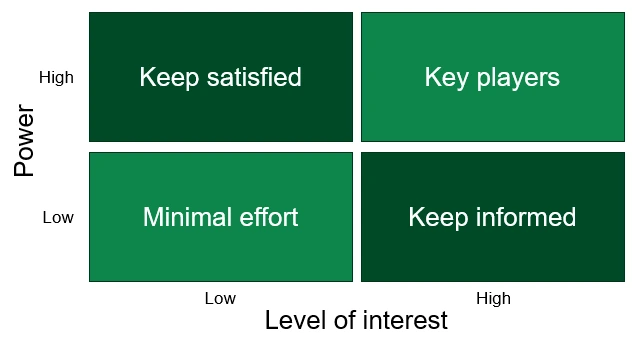A Stakeholder Analysis Model is part of stakeholder management and involves identifying stakeholders and their roles and responsibilities. This can be done through interviews, workshops, surveys, and other feedback-gathering techniques. Consider who will be affected by the implementation of an Enterprise Architecture, who will have influence or power over it, or who will have a stake in whether or not the implementation is successful.
These may include (senior) management, various roles in the project organization, roles in the customer organization, alliance partners, system developers, suppliers, customers, etc. When identifying stakeholders, it is important not to look only at one’s own organization, as there may be influential stakeholders outside the organization. This has already been taken into account during the creation of the Organization Map.
Gathering information
Ask questions to arrive at the most complete list of stakeholders possible:
- Who makes the decisions?
- Who are the go-to people in the department or unit?
- Who else has influence?
- Who has specific or specialized skills that are needed?
The answers to these questions provide insight into the decision-making hierarchy, as well as who has and can exercise influence within the organization. However, in some cases, this is a person who is often called upon to express an opinion or determine a direction or course of action. These are the influencers. They often attend important meetings and are valued by their peers and superiors. Nevertheless, influencers do not necessarily have to be in a formal position of power like managers.
Applying the method
After identifying stakeholders, the architect must analyze these groups to understand their needs and expectations. This can help prioritize their requirements and determine the best way to design the architecture to meet their needs. This can be done using a Stakeholder Analysis Model [1].
When creating a Stakeholder Analysis Model, it is important to find out how much influence the stakeholder has over a number of issues. To gain insight into this, a Stakeholder Power Grid can be created. Stakeholder classification is best done based on the level of power and influence they have and the level of interest and/or involvement. A simple matrix table can be used to assign a classification to a particular stakeholder.

Classifying stakeholders
The Stakeholder Power Grid shows which classifications can be assigned to stakeholders. At the same time, each classification comes with a set of requirements regarding the stakeholder’s communication needs.
- What information does the stakeholder need?
- Which communication frequency is appropriate?
- What is the most appropriate method of communication?
The answers to these questions form the basis of the Communications Plan.
Stakeholder Power Grid

A Stakeholder Power Grid is divided into four quadrants. Each quadrant has specific attributes that apply to the stakeholders in that quadrant.
- Key players. This classification indicates that these are stakeholders with a high level of interest and power within the organization. Therefore, the frequency of communication to this group of stakeholders will be the highest. For example, data and process owners have a high level of interest and power.
- Keep satisfied. Stakeholders classified as Keep satisfied have the same level of power in the organization as the Key players, but their level of interest is lower. Therefore, this group can be informed with a slightly lower frequency. E.g., an organization’s C-level functions fall into this classification.
- Keep informed. The level of interest among this group of stakeholders is high, but the power they can exercise within the organization is lower. Nevertheless, it is wise to keep this group informed on a regular basis. For this group, the choice is between informing them by email or in the form of a meeting (physical or digital). E.g., a stakeholder in this classification is the program manager.
- Minimal effort. Although this term has a negative connotation, this is far from the intention. As a matter of fact, it refers to stakeholders in this group having a low level of interest and power. However, this group can still contain stakeholders that are very important to the implementation of the Enterprise Architecture. To illustrate, the Employees group falls into this classification.
The assigned classifications are used in the creation of the Communications Plan.
More information
For additional information about creating a Stakeholder Analysis Model or a Stakeholder Power Grid, please refer to Chapter 8, Sections 8.2.2.1 through 8.2.2.3, of my book Getting Started with Enterprise Architecture.
Back to
[1] The Open Group, “Stakeholder Management”, in The TOGAF® Standard, 10th Edition, Architecture Development Method, ’s-Hertogenbosch: Van Haren Publishing, 2022.
